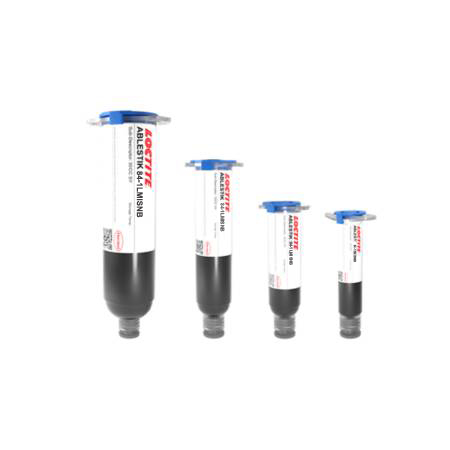LOCTITE ABLESTIK 84-1LMISNB
- Long work life
- High purity
- Electrically conductive
Product Description
LOCTITE ABLESTIK 84-1LMISNB electrically conductive adhesive is designed for semiconductor packaging applications. This halogen free, heat curable adhesive is filled with silver and has high purity. Its poisson's ration, as with the majority of adhesives is 0.33.
LOCTITE ABLESTIK 84-1LMISNB meets the requirements of MIL-STD-883, Method 5011.
Cure Schedule
- 1 hour @ 175°C
- 30 minutes @ 200°C
Technical Specifications
| General Properties | |||||||||||
| Density (g) | 3.4 g/cm3 | ||||||||||
| Work life @25°C Work life @25°C Work life is the amount of time we have to work with a material until it is no longer able to be easily worked and applied on a substrate. It is based on the change in viscosity and it can rely on the application requirements. | 168 hours | ||||||||||
| |||||||||||
| Thermal Properties | |||||||||||
| Glass Transition Temperature (Tg) Glass Transition Temperature (Tg) The glass transition temperature for organic adhesives is a temperature region where the polymers change from glassy and brittle to soft and rubbery. Increasing the temperature further continues the softening process as the viscosity drops too. Temperatures between the glass transition temperature and below the decomposition point of the adhesive are the best region for bonding. The glass-transition temperature Tg of a material characterizes the range of temperatures over which this glass transition occurs. | 115 °C | ||||||||||
| Thermal Conductivity Thermal Conductivity Thermal conductivity describes the ability of a material to conduct heat. It is required by power packages in order to dissipate heat and maintain stable electrical performance. Thermal conductivity units are [W/(m K)] in the SI system and [Btu/(hr ft °F)] in the Imperial system. | 3.5 W/m.K | ||||||||||
| Weight Loss @ 300°C | 0.45 % | ||||||||||
| |||||||||||
| Electrical Properties | |||||||||||
| Volume Resistivity Volume Resistivity Volume resistivity, also called volume resistance, bulk resistance or bulk resistivity is a thickness dependent measurement of the resistivity of a material perpendicular to the plane of the surface. | 2.0x10-4 Ohms⋅cm | ||||||||||
| Mechanical Properties | |||||||||||
| |||||||||||
| |||||||||||
| Chemical Properties | |||||||||||
| |||||||||||
| Physical Properties | |||||||||||
| Viscosity Viscosity Viscosity is a measurement of a fluid’s resistance to flow. Viscosity is commonly measured in centiPoise (cP). One cP is defined as the viscosity of water and all other viscosities are derived from this base. MPa is another common unit with a 1:1 conversion to cP. A product like honey would have a much higher viscosity -around 10,000 cPs- compared to water. As a result, honey would flow much slower out of a tipped glass than water would. The viscosity of a material can be decreased with an increase in temperature in order to better suit an application | 14,000 mPa.s | ||||||||||
Additional Information
What is the Density of 84-1LMI?
Density is typically stated for the wet state of the material. Cured density for die attach materials will be a few % higher but this is not a value that we measure. Generally, uncured (wet state) density is important for calculating usage while cured density is important for running modelling based on thermo-mechanical properties.
84-1LMI series are all “solvent free” so the weight loss on cure is small, and therefore the change in density during cure is also small.
Can I mix two die attach syringes together?
Customers should never remix the materials as it will change properties like TI. Please note that if you remix without our approval then we are no longer responsible for the material's end quality.
If you want to centrifuge them for void removal then, of course, this is a standard procedure for individual syringes. In this case 1 to 2 minutes at 1000rpm is sufficient on a planetary mixer. But mixing two syringes together is not advised or supported. Please contact us to see how we can resolve your issues without having to do this workaround.




